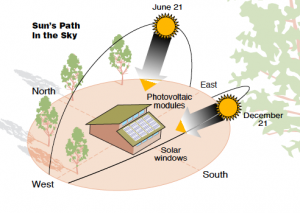Originally posted Posted on BCIT Update on March 23, 2014 by Life at BCIT Blogger Rosa Lin, to see the original story click here.
As mentioned in my preceding post, our beautiful new campus model, the 21-feet-tall living wall between NE2 and NE4, is rare because she faces north.

Sunpath and building orientation are extremely important topics in building science and architecture. Image courtesy of greenpassivesolar.com
Dr. Maureen Connelly, a key player driving the Living Wall and Elevated Lab project (and my thesis supervisor), said that it is generally more common to see living walls installed on the south side, which makes our north-facing living wall quite unique. Shade-tolerant plants were especially selected for this wall, and will be monitored closely for species viability. I thought about this for a while, and finally realized just now how clever of a research precept it really is.

Shade tolerant plants. Consider for northern gardens, but no heavy root vegetables on the living walls… yet! Image by Homesteady@Facebook via SpoutAcademy
While south- and west-side living wall installations are generally recommended for “better” sunlight and heat-mitigation effects, in our climate region, putting a living wall on the south facade directly competes with solar-related south-facing functions, like daylighting and solar harvest. Us northerly people (especially sun-starved Vancouverites during wintertime!) love southern exposure: we like having windows, patios, sliding glass doors, and storefronts on the south side, for the sun! We like our gardens (and solar panels) to be on the south side too, space-permitting. There is plenty of competition for comfortable sun exposure, so the remaining options available for putting up living wall systems will more likely not have great sun exposure. In other words, there may, statistically speaking, be more application for living walls “in the shade,” or on north-facing walls.
This, then, makes a very strong case for studying shade-tolerant plant species viability on outdoor living wall systems. If we can figure out the perfect plants to grow beautifully on a shady living wall… then we can have more knowledge and more options for transforming bare urban walls into lush vertical gardens, even if they are mostly in the shade!
Leave a Reply